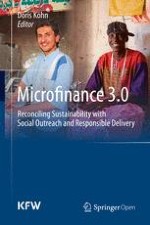Open Access 2013 | Open Access | Book

Microfinance 3.0
Reconciling Sustainability with Social Outreach and Responsible Delivery
Editor: Doris Köhn
Publisher: Springer Berlin Heidelberg
Open Access 2013 | Open Access | Book

Editor: Doris Köhn
Publisher: Springer Berlin Heidelberg
This book focuses on the achievements, current trends and further potential of microfinance to scale-up and serve many more clients with financial services that enable them to improve their living conditions. The book asks what it takes to achieve sustainable impact: to know your clients and to understand their needs, to treat them in a fair and transparent way, and to safeguard the synthesis between the financial and social dimension of sustainable microfinance. The book also sheds light on the future funding landscape and what is necessary to bring more commercial funders on board while ensuring that these new funders will continue the commitment to responsible finance. While being forward looking, the book reflects the debate on core values of microfinance, triggered by recent criticisms of an approach that was hailed as a panacea in the beginning and which had proved over time as one of the most effective models of development finance. These criticisms emerged over signs of overheating in some markets, particularly the 2010 events in Andhra Pradesh, and turned into an assumption of a worldwide microfinance crisis, putting seriously at stake the good reputation microfinance had enjoyed so far.